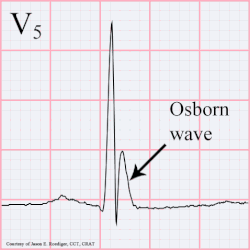



AJ wave — also known as Osborn wave, camel-hump sign, late delta wave, hathook junction, hypothermic wave,[1] K wave, H waveorcurrent of injury — is an abnormal electrocardiogram finding.[2]
J waves are positive deflections occurring at the junction between the QRS complex and the ST segment,[3][4] where the S point, also known as the J point, has a myocardial infarction-like elevation.
They are usually observed in people suffering from hypothermia with a temperature of less than 32 °C (90 °F),[5] though they may also occur in people with very high blood levels of calcium (hypercalcemia), brain injury, vasospastic angina, acute pericarditis, or they could also be a normal variant.[citation needed] Osborn waves on ECG are frequent during targeted temperature management (TTM) after cardiac arrest, particularly in patients treated with 33 °C.[6] Osborn waves are not associated with increased risk of ventricular arrhythmia, and may be considered a benign physiological phenomenon, associated with lower mortality in univariable analyses.[6]
The prominent J deflection attributed to hypothermia was first reported in 1938 by Tomaszewski. These waves were then definitively described in 1953 by John J. Osborn (1917–2014) and were named in his honor.[7] Over time, the wave has increasingly been referred to as a J wave, though is still sometimes referred to as the Osborn wave in most part due to Osborn's article in the American Journal of Physiology on experimental hypothermia.[8]
|
Signs and symptoms relating to the circulatory system
| |||||||||
|---|---|---|---|---|---|---|---|---|---|
| Chest pain |
| ||||||||
| Auscultation |
| ||||||||
| Pulse |
| ||||||||
| Other |
| ||||||||
| Shock |
| ||||||||
| Cardiovascular disease |
| ||||||||
| Vascular disease |
| ||||||||
|
Cardiovascular disease (heart)
| |||||||||||||||||||||||
|---|---|---|---|---|---|---|---|---|---|---|---|---|---|---|---|---|---|---|---|---|---|---|---|
| Ischemia |
| ||||||||||||||||||||||
| Layers |
| ||||||||||||||||||||||
| Conduction / arrhythmia |
| ||||||||||||||||||||||
| Cardiomegaly |
| ||||||||||||||||||||||
| Other |
| ||||||||||||||||||||||